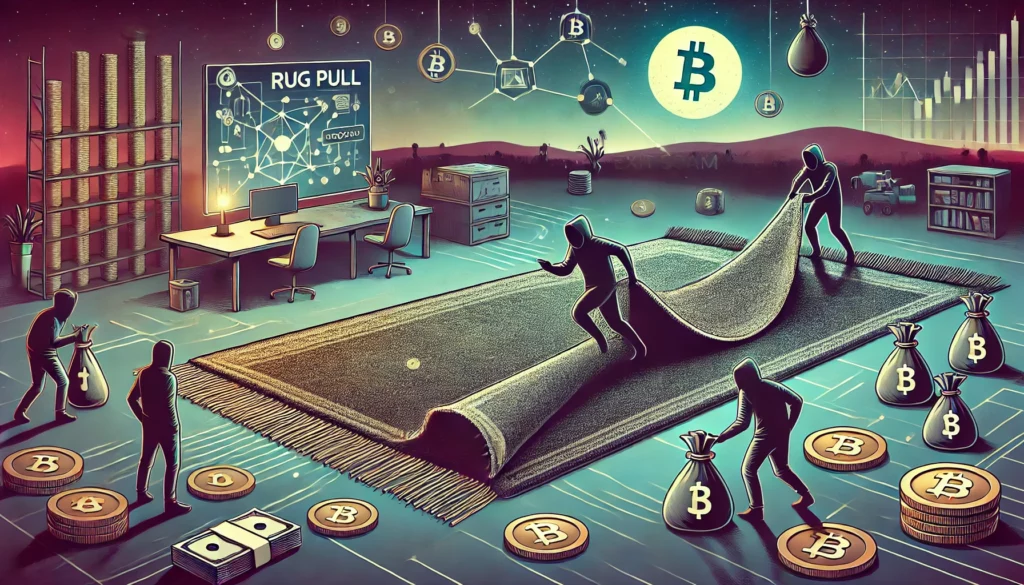The cryptocurrency space has long been hailed for its ability to democratize finance, offering new opportunities for investment and innovation. However, this decentralized, largely unregulated environment has also provided fertile ground for scams, including rug pulls and exit scams. These fraudulent activities have become a significant concern for investors, as they can result in devastating financial losses, often within a short period of time.
A rug pull occurs when the developers of a cryptocurrency project or a decentralized finance (DeFi) protocol suddenly withdraw all the liquidity or funds from the platform, leaving investors with worthless tokens. Similarly, an exit scam happens when the creators of a project disappear with investors’ funds, abandoning the platform entirely. These scams prey on the trust and enthusiasm of the crypto community, taking advantage of the lack of regulatory oversight and the complex nature of blockchain technology.
This article will explore how rug pulls and exit scams operate, the red flags that investors should be aware of, and strategies for identifying and avoiding such deceptive projects. By understanding how these scams work and implementing best practices for due diligence, investors can better protect themselves and their investments in the volatile world of cryptocurrency.
What Are Rug Pulls and Exit Scams?
Rug Pulls
A rug pull typically occurs in the context of DeFi projects or meme coins, where new tokens or coins are launched on decentralized exchanges (DEXs) like Uniswap or PancakeSwap. In a rug pull scenario, the developers create a new token, pair it with a popular cryptocurrency (often Ethereum or Binance Coin), and then list it on a decentralized exchange with a substantial amount of liquidity. Early investors, drawn by promises of high returns or flashy marketing campaigns, buy into the token, increasing its price and liquidity.
However, once the token has gained sufficient traction, the developers suddenly withdraw the liquidity (often referred to as “pulling the rug”), leaving the investors with worthless tokens. In some cases, the developers may also sell their own tokens during this process, further driving down the price and making it impossible for investors to sell their holdings at a reasonable value. The developers then disappear, often leaving behind no trace or means for investors to recover their funds.
Exit Scams
An exit scam refers to a situation where the creators of a cryptocurrency project or ICO (Initial Coin Offering) scheme abruptly disappear with the raised funds, abandoning the project altogether. Unlike rug pulls, which often happen in the DeFi and token markets, exit scams can occur in a variety of scenarios, including:
- Initial Coin Offerings (ICOs): A project raises funds through an ICO, promising investors future returns or access to a blockchain-based product, but once the funds are collected, the project team disappears.
- Crypto Exchanges or Platforms: Scammers set up fake crypto exchanges, encourage users to deposit funds, and then shut down the platform, taking the funds with them.
- Token or NFT Projects: Developers launch a new token or NFT collection with big promises but vanish after collecting the investments, leaving investors without their assets.
The result of an exit scam is often the total loss of invested funds, as scammers typically make it impossible to trace them or reclaim the stolen money.
Red Flags of Rug Pulls and Exit Scams
While rug pulls and exit scams are a pervasive threat in the cryptocurrency market, there are several red flags that investors should be aware of when evaluating a new project. By recognizing these warning signs, investors can avoid falling victim to such deceptive activities.
1. Lack of Transparency and Anonymous Team
One of the first signs of a potentially fraudulent project is a lack of transparency. If the project’s team is anonymous or provides little information about their background, it could be a major red flag. Many rug pulls and exit scams are perpetrated by developers who hide behind pseudonyms, making it difficult to track them down or hold them accountable. Legitimate projects usually have publicly identifiable teams with verifiable credentials and professional experience in the blockchain space.
Before investing in a project, always research the team’s background and check their social media profiles, LinkedIn pages, or other platforms for transparency and credibility. If the project creators cannot be verified, or if there is a lack of public information, this is often a warning sign.
2. Unrealistic Promises and Hype
Rug pulls and exit scams are often built on over-the-top promises of quick profits, massive returns, and overnight success. If a project is promising returns that sound too good to be true, it probably is. Scammers often prey on the excitement and emotional impulse of investors, particularly in the case of new tokens, DeFi platforms, or NFT collections.
If the marketing materials seem overly hype-driven with little substance to back up the claims, exercise caution. Pay attention to whether the project provides any tangible utility or real-world applications for its token, or if it’s simply relying on hype to generate interest.
3. Unverified Smart Contracts and Code
In the world of DeFi and blockchain projects, smart contracts are the backbone of the system, determining how transactions, token issuance, and liquidity functions. Before investing, ensure that the project’s smart contracts are audited by a reputable third-party auditor. Rug pull scammers often create unaudited or poorly written smart contracts with hidden features that allow them to access and drain the liquidity pool.
You can check if a project has been audited by platforms such as Certik, Quantstamp, or Hacken, which provide detailed reports on the security of smart contracts. Lack of a credible audit or the use of unaudited code is a significant risk.
4. Abnormal Tokenomics
Tokenomics, or the economic structure behind a cryptocurrency or token, plays a crucial role in ensuring a project’s long-term viability. Rug pulls and exit scams often involve unusual or unsustainable tokenomics, such as highly inflationary token distributions, large developer allocations, or token “vesting” periods that benefit the creators more than the investors.
In many rug pull cases, developers retain a large percentage of the tokens and can sell them when the price spikes, while investors are left holding tokens with no liquidity or value once the developers withdraw the liquidity. Always analyze the tokenomics carefully, including how tokens are distributed, the vesting schedule, and the incentives for long-term growth.
5. Low Liquidity or Sudden Price Drops
A telltale sign of a rug pull is when liquidity on a decentralized exchange (DEX) is drastically reduced or disappears entirely. In a legitimate project, liquidity should be sufficient for investors to buy and sell the token without drastic slippage or price manipulation. If you notice a sudden lack of liquidity or a sharp drop in token price without any news or reason, it’s likely that a rug pull has occurred. Often, this happens after the developers remove liquidity from the pool, rendering the token worthless.
How to Avoid Rug Pulls and Exit Scams
Despite the risks, there are several steps investors can take to protect themselves from falling victim to rug pulls and exit scams:
- Conduct Thorough Research: Always conduct detailed research before investing in any cryptocurrency project. This includes examining the team, reading the whitepaper, evaluating the project’s roadmap, and verifying smart contract audits.
- Stick to Reputable Platforms: Invest only in projects listed on well-known, reputable exchanges or platforms. Projects with little visibility or found on obscure platforms are often higher risk.
- Use Trusted Auditors: Ensure that the project’s smart contracts have been independently audited by trusted security firms. Audits can help uncover vulnerabilities in the code that might be exploited by scammers.
- Avoid FOMO and Unverified Hype: If a project is too good to be true, it probably is. Stay cautious of projects relying on hype and fear of missing out (FOMO) to attract investors.
- Track Token Performance: Monitor the token’s liquidity and price movements. A sudden drop in liquidity or an abnormal price drop could indicate a scam.
Rug Pulls and Exit Scams
Rug pulls and exit scams represent some of the most dangerous and prevalent threats in the cryptocurrency space, often leading to devastating financial losses for unsuspecting investors. However, by staying informed, conducting thorough research, and being vigilant for red flags, investors can significantly reduce their risk of falling victim to these scams. The key to success in the cryptocurrency world is not only identifying promising projects but also knowing how to safeguard oneself against the growing number of fraudulent schemes. With the right precautions, cryptocurrency investors can navigate the landscape safely, avoiding deceptive projects and making informed, secure investment choices.


